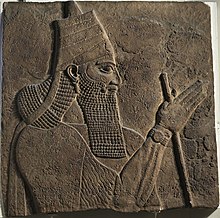| Tiglath-Pileser III | |
|---|---|
 Tiglath-Pileser III as depicted on a stele from the walls of his royal palace | |
| King of the Neo-Assyrian Empire | |
| Reign | 745–727 BC |
| Predecessor | Ashur-nirari V |
| Successor | Shalmaneser V |
| Born | c. 795 BC[a] (?) |
| Died | 727 BC (aged c. 68) |
| Spouse | Iaba |
| Issue | Shalmaneser V Sargon II (?) Sin-ahu-usur (?) |
| Akkadian | Tukultī-apil-Ešarra |
| Dynasty | Adaside dynasty |
| Father | Adad-nirari III or Ashur-nirari V |
Tiglath-Pileser III[b] (Neo-Assyrian Akkadian: 𒆪𒋾𒀀𒂍𒈗𒊏, romanized: Tukultī-apil-Ešarra,[4] meaning "my trust belongs to the son of Ešarra";[2][c] Biblical Hebrew: תִּגְלַת פִּלְאֶסֶר, romanized: Tīglaṯ Pīlʾeser) was the king of the Neo-Assyrian Empire from 745 BC to his death in 727. One of the most prominent and historically significant Assyrian kings, Tiglath-Pileser ended a period of Assyrian stagnation, introduced numerous political and military reforms and more than doubled the lands under Assyrian control. Because of the massive expansion and centralization of Assyrian territory and establishment of a standing army, some researchers consider Tiglath-Pileser's reign to mark the true transition of Assyria into an empire. The reforms and methods of control introduced under Tiglath-Pileser laid the groundwork for policies enacted not only by later Assyrian kings but also by later empires for millennia after his death.
The circumstances of Tiglath-Pileser's rise to the throne are not clear. Because ancient Assyrian sources give conflicting accounts concerning Tiglath-Pileser's lineage and there are records of a revolt at around the time of his accession, many historians have concluded that Tiglath-Pileser was a usurper, who seized the throne from his predecessor Ashur-nirari V, who was either his brother or his father. Other historians postulate that the evidence could just as easily be interpreted as Tiglath-Pileser inheriting the throne through legitimate means and the debate remains unresolved.
Tiglath-Pileser early on increased royal power and authority through curbing the influence of prominent officials and generals. After securing some minor victories in 744 and 743, he defeated the Urartian king Sarduri II in battle near Arpad in 743. This victory was significant since Urartu had for a brief time equalled Assyrian power; Sarduri had eleven years earlier defeated Tiglath-Pileser's predecessor Ashur-nirari. After defeating Sarduri, Tiglath-Pileser turned his attention to the Levant. Over the course of several years, Tiglath-Pileser conquered most of the Levant, defeating and then either annexing or subjugating previously influential kingdoms, notably ending the kingdom of Aram-Damascus. Tiglath-Pileser's activities in the Levant were recorded in the Hebrew Bible. After a few years of conflict, Tiglath-Pileser conquered Babylonia in 729, becoming the first king to rule as both king of Assyria and king of Babylon.
- ^ Yamada & Yamada 2017, p. 390.
- ^ a b c Radner 2012.
- ^ Albright 1949, p. 163.
- ^ Yamada & Yamada 2017, p. 391.
Cite error: There are <ref group=lower-alpha> tags or {{efn}} templates on this page, but the references will not show without a {{reflist|group=lower-alpha}} template or {{notelist}} template (see the help page).